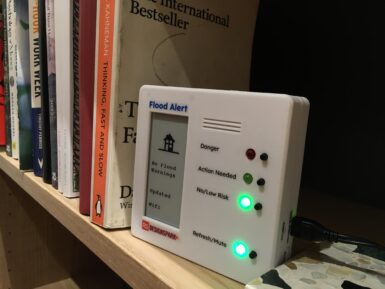
Overview
Based on the ESP8266 Wi-Fi transceiver module and the CH340 USB converter chip, this compact (Open Source) development and prototyping board is ideal for IoT applications.
The Wi-Fi module is compatible with the 802.11 b/g/n standard at 2.4 GHz, has an integrated TCP/IP stack, 19.5 dBm output power, data interface (UART / HSPI / I2C / I2S / Ir Remote Control GPIO / PWM) and PCB antenna.
It also has a micro USB connector and reset button. Programmable with Arduino IDE, it includes interpreters for processing commands for languages such as LUA.
Tech specs
- Model: ESP8266-12E
- Wireless Standard: 802.11 b/g/n
- Frequency range: 2.4 GHz - 2.5 GHz (2400M-2483.5M)
- Wi-Fi mode: Station / SoftAP / SoftAP+station
- Stack: Integrated TCP/IP
- Output power: 19.5dBm in 802.11b mode
- Data interface: UART / HSPI / I2C / I2S / Ir
- Remote Control GPIO / PWM
- Supports protection mode: WPA / WPA2
- Encryption: WEP / TKIP / AES
- Power supply: from 4.5 VDC to 9 VDC (VIN) or via micro USB connector
- Consumption: with continuous Wi-Fi transmission about 70 mA (200 mA MAX) - in standby < 200µA
- Operating temperature: from -40°C to +125°C
- Dimensions (mm): 58×31.20×13
- Weight: 10 grams
Conformities
Get Inspired
An IoT Moisture sensor that sends moisture data from an Arduino Nano 33 IoT to the Arduino IoT Cloud

As climate change continues to worsen, events such as heavy rains, hurricanes, and atmospheric rivers have only intensified, and with them, large amounts of flooding that pose serious risks to life and property. Jude Pullen and Pete Milne, therefore, have responded by creating a "physical app" that can show the potential for flood dangers in real-time with sound, lights, and an ePaper display. The Arduino Nano 33 IoT powering the Flood Alert device sources its data from the UK Environmental Agency’s API to get statistics on an area’s latest risk level along with an extended description of what to expect. Initially, the electronics were mounted to a breadboard and housed within a cardboard enclosure, but a later revision moved everything to soldered protoboard, a 3D-printed case, and even added a piezoelectric buzzer to generate audible alerts. For now, the Flood Alert’s sole source of data is the aforementioned API, but Pullen hopes to expand his potential data sources to include “hyper-local” sensors that can all be aggregated and analyzed to give a much more precise view of flooding in a smaller area. To learn more about Flood Alert and its myriad applications to local communities and beyond, check out the original long read article’ is available at DesignSpark.






